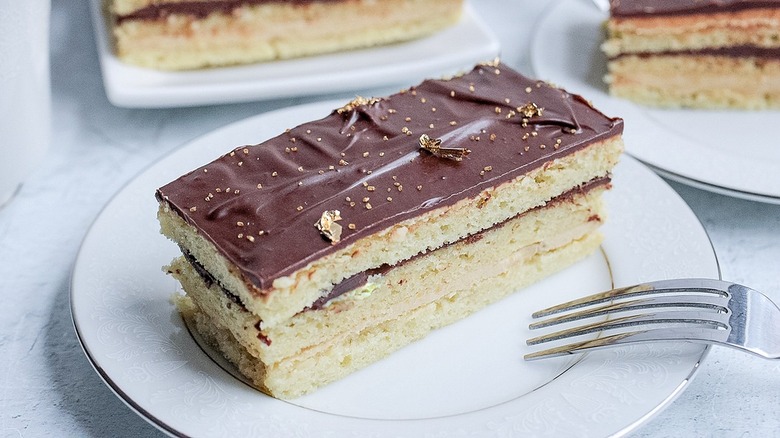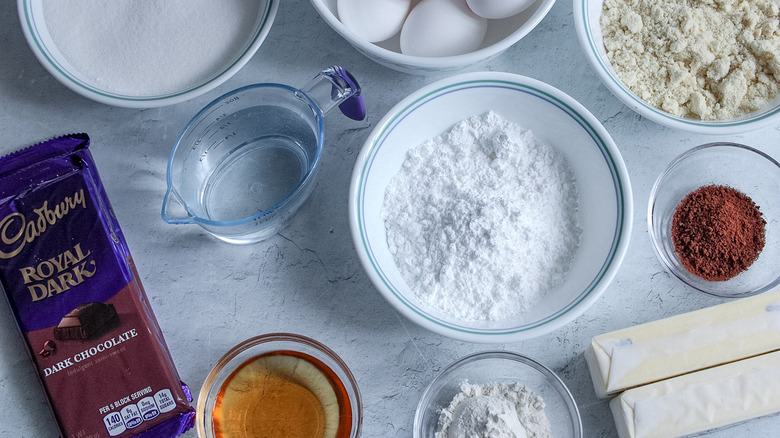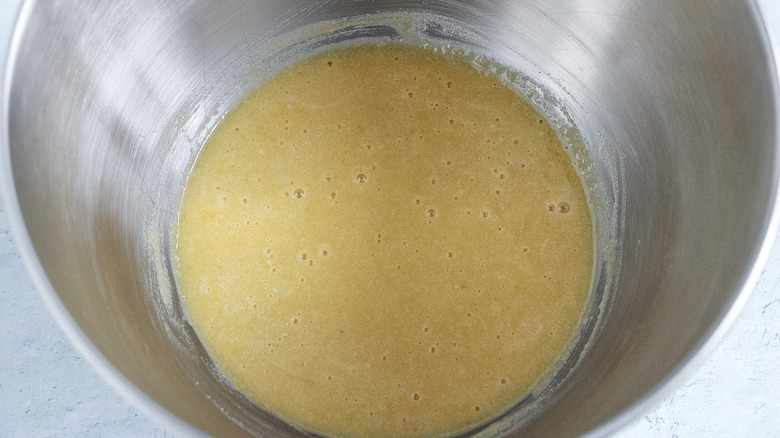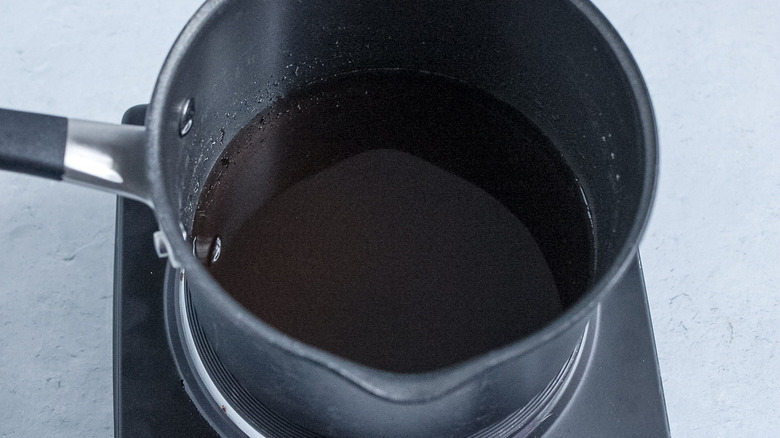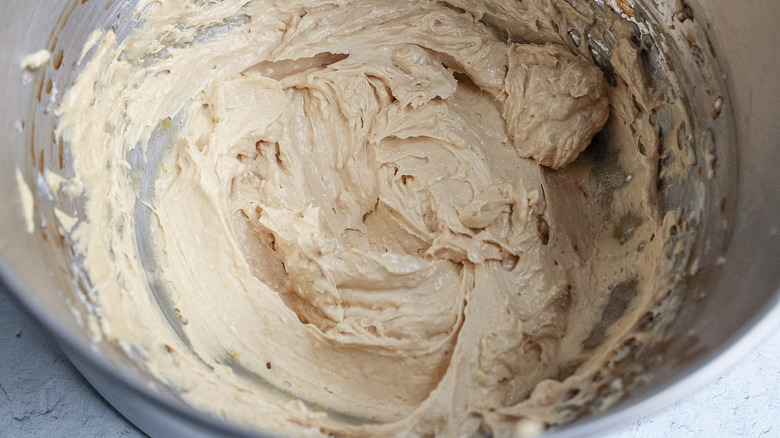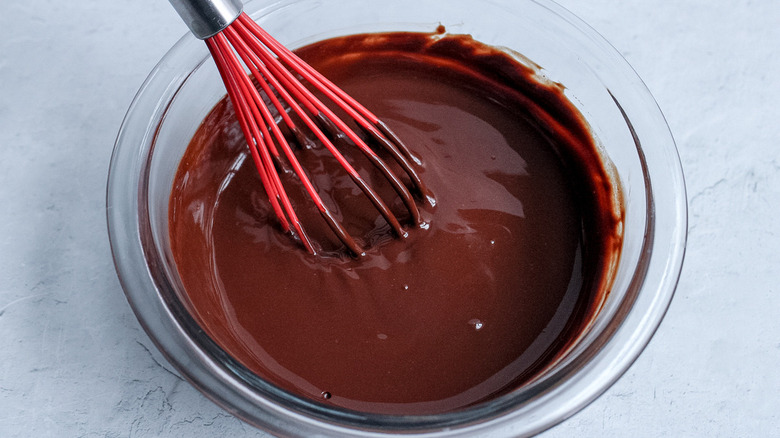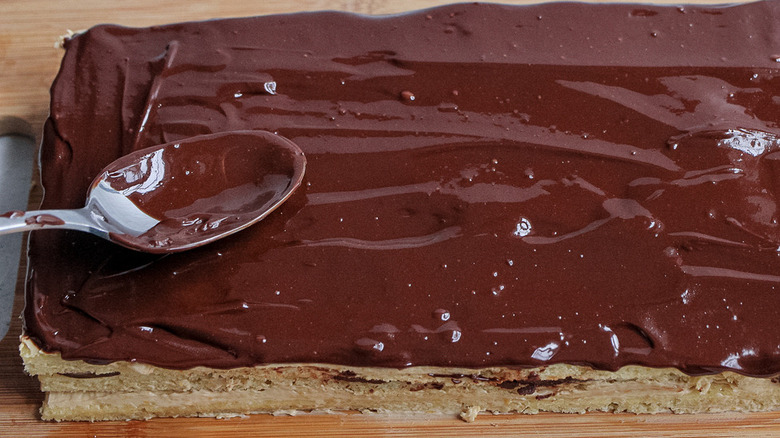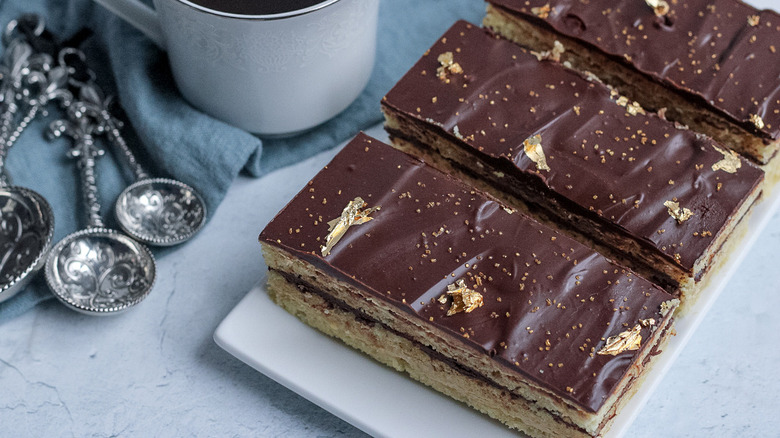Classic Opera Cake Recipe
Opera cake is a French dessert consisting of three layers of delicate coffee syrup-soaked almond sponge cake, alternating with layers of coffee-flavored buttercream and chocolate ganache, according to recipe developer, Jessica Morone. Morone also happens to be the food photographer and blogger to craft this classic opera cake recipe, and it is every bit as decadent as it sounds. According to The Good Life France, opera cake was named for the French Opera House, with the layers of cake resembling the mezzanine rows in the opera house itself. The confection was dreamed up by the French pastry chef, Cyriaque Gavillon, who wanted to craft a dessert that gives you all of the flavors with ease. In just one bite, you'll taste every single flavor and texture that this opera cake has to offer!
"Opera cake is definitely an elaborate recipe," Morone concedes, "but it's so delicious that it's worth all the time and effort it takes." Moreover, it's meant to make an impression. "I would make this recipe if I was having a fancy dinner or really wanted to impress someone because these little cakes are super impressive," notes Morone, who, as you can see, decorated the top of hers with gold sprinkles and edible gold leaf. However, she didn't include either in the recipe because it's more customary to let the ganache topping shine by itself. And shine it will, as you'll soon discover — let's dive right in to this impressive recipe.
Gather your ingredients for opera cake
To make Morone's recipe for opera cake, you'll need the ingredients for each of the cake, the coffee-flavored syrup, the coffee-flavored buttercream, and the chocolate ganache. While that may seem like a lot, the reality is that many of the ingredients do double duty. So altogether, you'll need only the following 10 ingredients: almond flour, all-purpose flour, confectioner's sugar, a half-dozen eggs, granulated sugar, unsalted butter, instant espresso powder, brandy (you could substitute Cognac, if you prefer), semi-sweet chocolate, and some water. You'll likely find that many of these ingredients are already sitting in your pantry at home!
Start by making the almond sponge cake layer
Set your oven to preheat to 425 F. Grease an 18×13-inch sheet pan, line it with parchment paper or a Silpat mat, then lightly grease the paper or mat. Separate three of the eggs, putting the three egg whites into one bowl, two egg yolks into a second bowl, and the third egg yolk into a third bowl.
Now that the eggs have been organized, grab a large bowl, and in it, beat together the almond flour, the all-purpose flour, the confectioner's sugar, one egg yolk, and three whole eggs. In a separate bowl, use an electric mixer to beat the three egg whites and ¼ cup granulated sugar until stiff peaks form. Gently fold the egg white mixture in. Next, melt two tablespoons of the butter by placing it in a small ovenproof bowl and placing the bowl in your oven for a minute. Then, gently fold the butter into the cake mixture. Pour the completed cake mixture into the prepared baking pan, spreading the batter evenly. Bake for eight to 10 minutes — that's all it needs since the sheet pan is shallow. You'll know the cake is done when it's lightly golden and springs back when you touch it. Let the cake cool until you can comfortably touch it without burning your fingers. Run a knife around the edges of the pan to loosen the cake from the pan.
Prepare the espresso syrup
In a small bowl, dissolve a teaspoon of the espresso powder into one tablespoon of water, and set aside for the moment. Dissolve ½ cup of granulated sugar in ½ cup of water in a small saucepan over medium heat, stirring constantly. Allow the liquid to come to a boil, then remove the saucepan from the heat source. Stir in the espresso water that you just made, along with the brandy. This is your espresso syrup, which you will be using to soak the sponge cake when it's time to assemble your opera cake. Set the espresso syrup aside so it can cool.
Make the espresso buttercream
In a small bowl, dissolve the remaining two teaspoons of espresso powder in one tablespoon of water. In a saucepan, bring another ½ cup of water and the remaining ½ cup of granulated sugar to a boil, stirring constantly until the sugar has dissolved fully. Once boiling, pop a candy thermometer into the mixture, and allow the mixture to reach 238 F.
While the sugar mixture is heating, add the two remaining egg yolks to the bowl of a stand mixer and beat for 1 minute. When the sugar and water mixture reaches 238 F, pour it into the bowl of the stand mixer in a slow, steady stream. Add in the espresso and water mixture, and continue beating on medium speed until the bowl of the mixer is completely cool, about five minutes. With the mixer still running, add in eight tablespoons of butter, one piece at a time, until the mixture becomes a silky buttercream. Set the buttercream aside.
Heat the chocolate to make ganache
Chop up six ounces of chocolate into small pieces, then place them into a medium-sized microwave-safe bowl, along with the remaining six tablespoons of butter. Heat in 30-second intervals, stirring between each interval, until the chocolate and the butter are melted and smooth — it should take about one and ½ minutes total. Stir in the remaining ounce of chocolate, until smooth. Place the ganache in the refrigerator until it has thickened to spreading consistency, about 20 minutes.
Start assembling your opera cake
This may surprise you, but assembling your opera cake is going to be quite easy. The first step in this process is slicing the cake into thirds (use a ruler, Morone recommends). Line your counter or a cutting board with parchment paper, and place the first layer of cake on the parchment paper. Brush the top of this first layer with the espresso syrup, then spread half of the espresso buttercream over the layer. Top with the second cake layer, brush on more coffee syrup, then spread some of the chocolate ganache on. Place the final layer of cake on top, brush on more espresso syrup, and then spread the last of the buttercream on top. Place the entire cake into the fridge for 30 minutes to allow the buttercream to chill.
Finish assembling your opera cake, and serve
As the cake cools in the fridge, reheat the remaining chocolate glaze for about 20 seconds in the microwave, until it is shiny and spreadable, but not hot. Spread the remaining ganache over the top of the cake, ensuring that it reaches the edges. Chill the cake in the fridge one last time, until it is firm. Trim the edges of the cake to make sure they're all even, then cut the cake into two-inch slices and serve! While this recipe is quite involved, it does come together easily, and the result is truly spectacular. The next time you're looking to impress with a dessert, give this opera cake recipe a try!
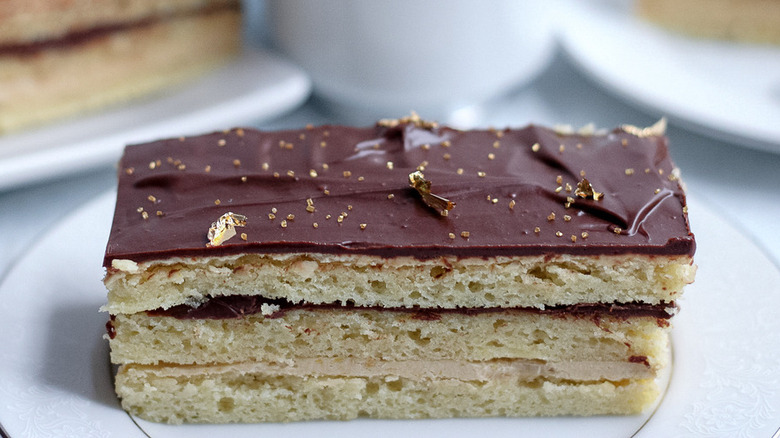
- 1 cup almond flour
- 3 tablespoons all-purpose flour
- ¾ cup confectioner's sugar
- 6 eggs, divided
- 1 ¼ cups granulated sugar, divided
- 1 cup unsalted butter, divided
- 3 teaspoons instant espresso powder, divided
- 1 cup + 2 tablespoons water, divided
- ¼ cup brandy
- 7 ounces semisweet chocolate
- Preheat your oven to 425 F.
- Grease an 18×13-inch sheet pan and then line it with parchment paper or a Silpat mat, and lightly grease that as well.
- Separate 3 eggs into 3 bowls as follows: all egg whites in the first bowl, 2 yolks in a second bowl, and the third yolk in a third bowl. Set aside the eggs.
- In a large bowl, make the cake mixture by beating the almond flour, all-purpose flour, confectioner's sugar, 1 egg yolk, and the remaining 3 whole eggs, until well combined.
- In a separate bowl, use an electric mixer to beat the 3 egg whites with ¼ cup of granulated sugar, until stiff peaks form.
- Gently fold the egg white mixture into the cake mixture.
- Melt 2 tablespoons of butter and gently fold that into the cake mixture.
- Pour this completed cake batter into the prepared sheet pan, spreading it evenly.
- Bake for 8 to 10 minutes, until the cake is lightly golden and springs back when you touch it.
- Let the cake cool, then run a knife around the edges of the pan to help loosen the cake from the pan.
- In a small bowl, dissolve 1 teaspoon of espresso powder in 1 tablespoon of water, and set aside. Combine ½ cup of water with ½ cup of granulated sugar in a small saucepan, stirring continuously until the sugar has dissolved. Bring to a boil, then remove the saucepan from the heat, and stir in the espresso/water mixture you just set aside, along with brandy. Set this espresso syrup aside to cool.
- In a small bowl, dissolve the remaining 2 teaspoons of espresso powder in 1 tablespoon of water. In a saucepan, bring another ½ cup of water and the remaining ½ cup of granulated sugar to a boil, stirring constantly until the sugar has dissolved fully.
- Once boiling, pop a candy thermometer into the mixture, and allow the mixture to reach 238 F.
- While the sugar mixture is heating, add the 2 remaining egg yolks to the bowl of a stand mixer and beat for 1 minute. When the sugar and water mixture reach 238 F, pour it into the bowl of the stand mixer in a slow, steady stream.
- Add in the espresso and water that you set aside earlier, and continue beating on medium speed until the bowl of the mixer is completely cool, about 5 minutes. With the mixer still running, add in 8 tablespoons of butter, 1 piece at a time, until the mixture becomes a silky buttercream. Set the buttercream aside.
- Chop 6 ounces of the chocolate bar into small pieces, place in a microwave-safe bowl along with the remaining 6 tablespoons of butter. Heat in 30-second intervals, stirring between each interval, until the chocolate and the butter are melted and smooth, about 1 ½ minutes. Stir in the remaining 1 ounce of chocolate and stir until smooth.
- Place the ganache in the refrigerator until it has thickened to spreading consistency, about 20 minutes.
- Cut the cake into 3 equal layers. Place the first layer on a flat surface lined with parchment paper.
- Brush the top of that first layer with some of the espresso syrup. Spread half of the buttercream evenly over the top of the first layer.
- Put the second layer on top of the first, then brush on more espresso syrup. Spread half of the ganache over the second layer.
- Place the final layer of cake on top. Brush this top layer of cake with more espresso syrup. Spread the remaining buttercream over this top layer.
- Chill the layered cake in the refrigerator for 30 minutes, until the buttercream is firm.
- Reheat the remaining ganache for about 20 seconds in the microwave, until it is shiny and spreadable, but not hot.
- Spread the remaining ganache evenly over the top of the cake. Chill in the refrigerator until the cake is firm.
- Trim away the edges of the cake with a sharp knife to make them even.
- Cut the cake into 2-inch slices, and serve immediately.
